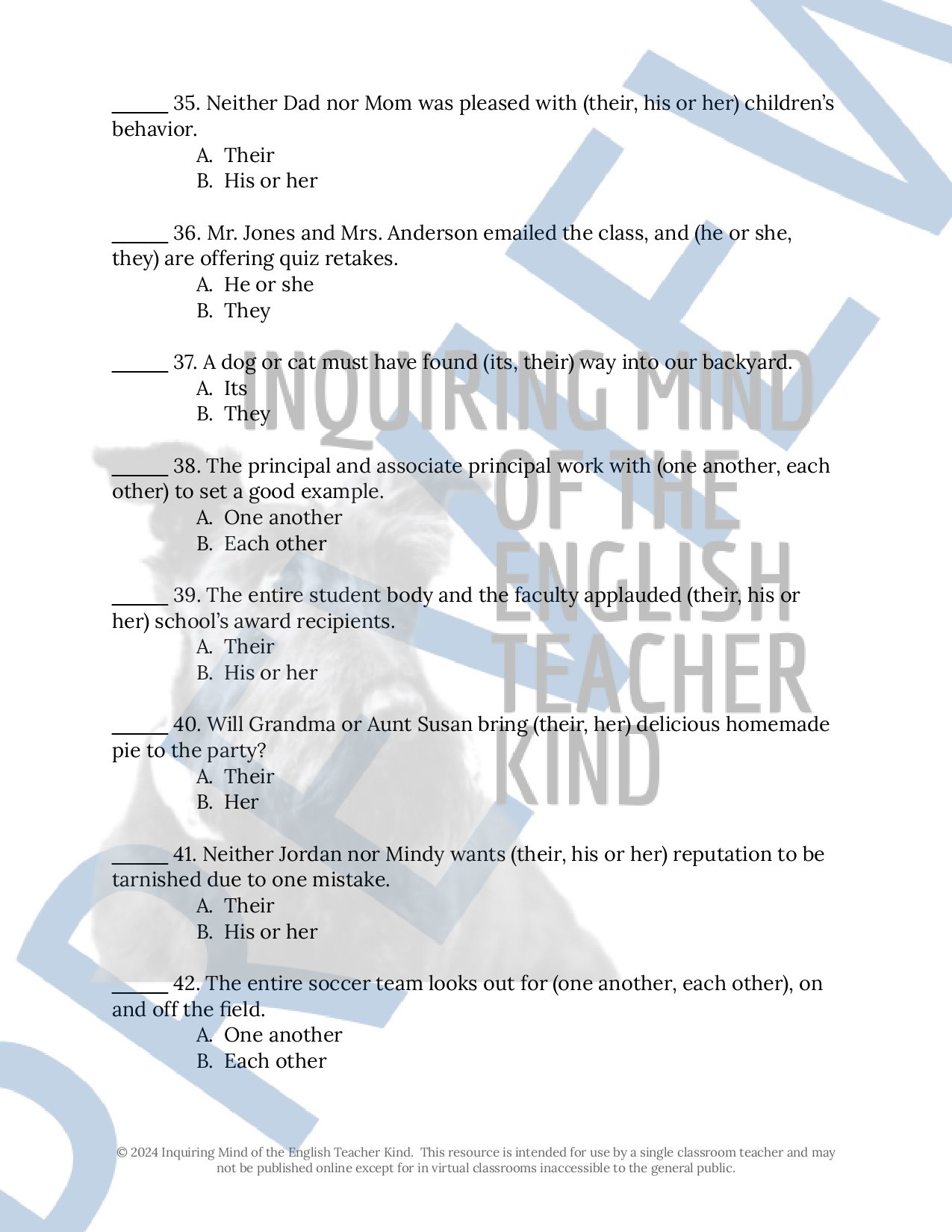 Image 1 of 8
Image 1 of 8

 Image 2 of 8
Image 2 of 8

 Image 3 of 8
Image 3 of 8

 Image 4 of 8
Image 4 of 8

 Image 5 of 8
Image 5 of 8

 Image 6 of 8
Image 6 of 8

 Image 7 of 8
Image 7 of 8

 Image 8 of 8
Image 8 of 8









Grammar Worksheet on Pronoun-Antecedent Agreement
Reinforce the standard conventions of academic writing and perform a quick check of students' knowledge with this grammar worksheet on pronoun-antecedent agreement. Delivered in printable Word Document format, as well as in PDF format, this resource conveniently offers the option to edit. An answer key is provided. (Alternatively, a self-grading Google Drive option is available.) By engaging with this resource, students will demonstrate an ability to:
Use a singular pronoun to refer to anybody, anyone, anything, each, either, everybody, everyone, everything, neither, nobody, no one, none, nothing, one, somebody, someone, or something
Use a plural pronoun to refer to both, few, many, or several
Discern whether to use an indefinite pronoun such as all, any, more, most, none, and some is singular or plural in context
Use a singular pronoun to refer to two or more singular antecedents joined by or or nor
Use a plural pronoun to refer to two or more antecedents joined by and
Recognize that a collective noun is singular when it refers to the group as a collective unit
Recognize that a collective noun is plural when it refers to the individual members of a group
Discern whether to use the pronoun each other or one another in context
Additional materials for teaching creative writing are available:
Reinforce the standard conventions of academic writing and perform a quick check of students' knowledge with this grammar worksheet on pronoun-antecedent agreement. Delivered in printable Word Document format, as well as in PDF format, this resource conveniently offers the option to edit. An answer key is provided. (Alternatively, a self-grading Google Drive option is available.) By engaging with this resource, students will demonstrate an ability to:
Use a singular pronoun to refer to anybody, anyone, anything, each, either, everybody, everyone, everything, neither, nobody, no one, none, nothing, one, somebody, someone, or something
Use a plural pronoun to refer to both, few, many, or several
Discern whether to use an indefinite pronoun such as all, any, more, most, none, and some is singular or plural in context
Use a singular pronoun to refer to two or more singular antecedents joined by or or nor
Use a plural pronoun to refer to two or more antecedents joined by and
Recognize that a collective noun is singular when it refers to the group as a collective unit
Recognize that a collective noun is plural when it refers to the individual members of a group
Discern whether to use the pronoun each other or one another in context
Additional materials for teaching creative writing are available:
Reinforce the standard conventions of academic writing and perform a quick check of students' knowledge with this grammar worksheet on pronoun-antecedent agreement. Delivered in printable Word Document format, as well as in PDF format, this resource conveniently offers the option to edit. An answer key is provided. (Alternatively, a self-grading Google Drive option is available.) By engaging with this resource, students will demonstrate an ability to:
Use a singular pronoun to refer to anybody, anyone, anything, each, either, everybody, everyone, everything, neither, nobody, no one, none, nothing, one, somebody, someone, or something
Use a plural pronoun to refer to both, few, many, or several
Discern whether to use an indefinite pronoun such as all, any, more, most, none, and some is singular or plural in context
Use a singular pronoun to refer to two or more singular antecedents joined by or or nor
Use a plural pronoun to refer to two or more antecedents joined by and
Recognize that a collective noun is singular when it refers to the group as a collective unit
Recognize that a collective noun is plural when it refers to the individual members of a group
Discern whether to use the pronoun each other or one another in context
Additional materials for teaching creative writing are available:
Preview this resource.
Reinforce the standard conventions of academic writing and perform a quick check of students' knowledge with this grammar worksheet on pronoun-antecedent agreement. Delivered in printable Word Document format, as well as in PDF format, this resource conveniently offers the option to edit. An answer key is provided.
